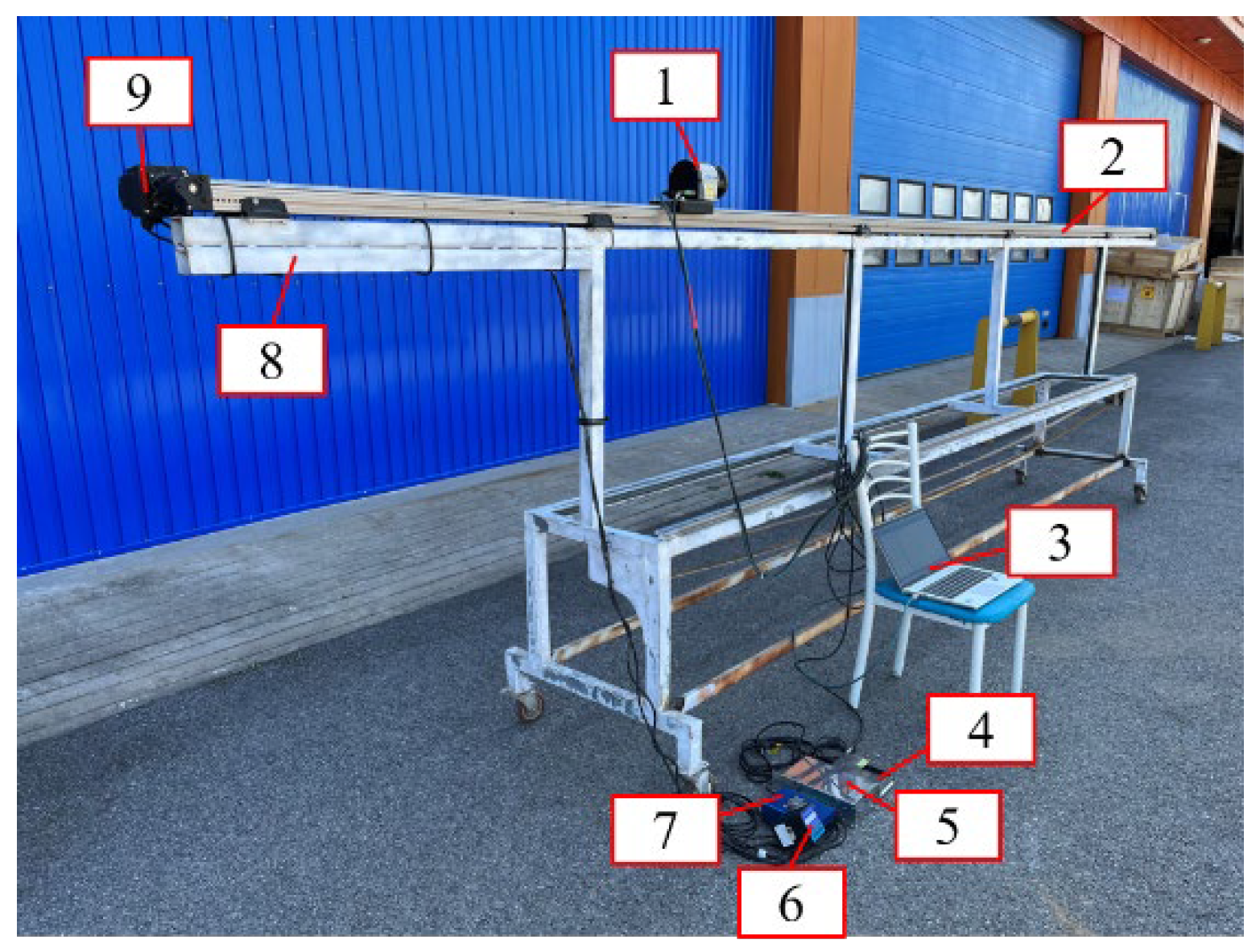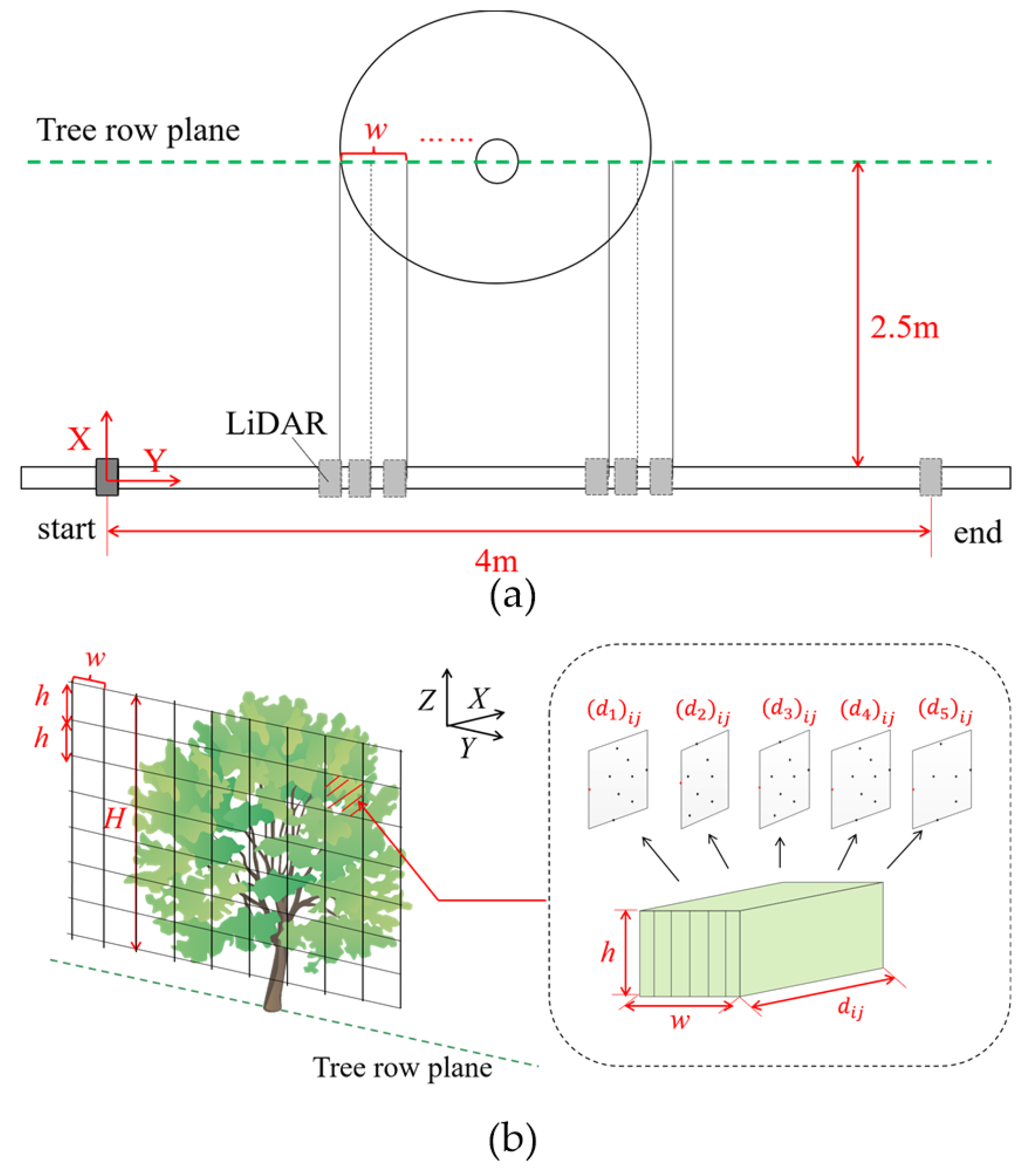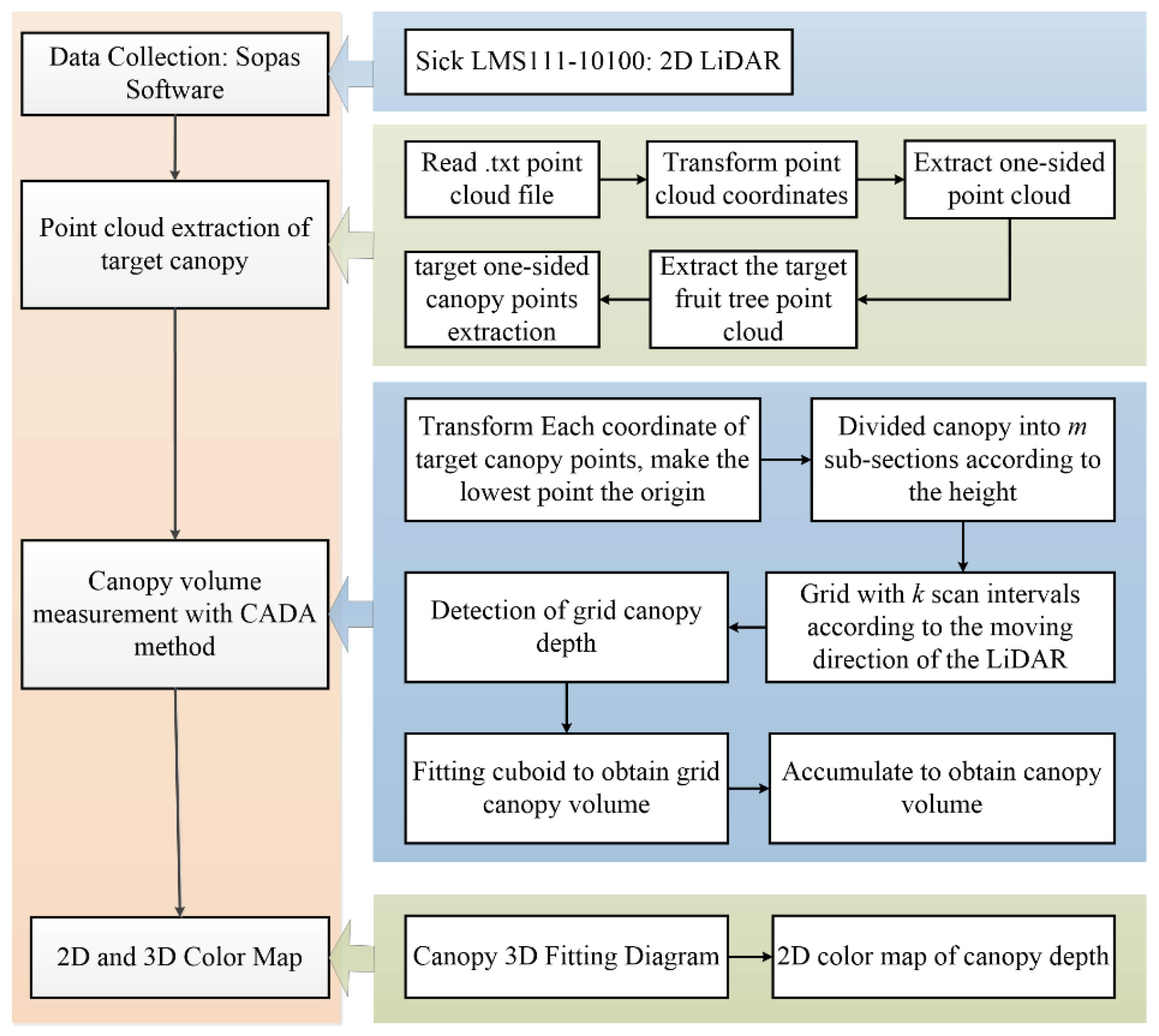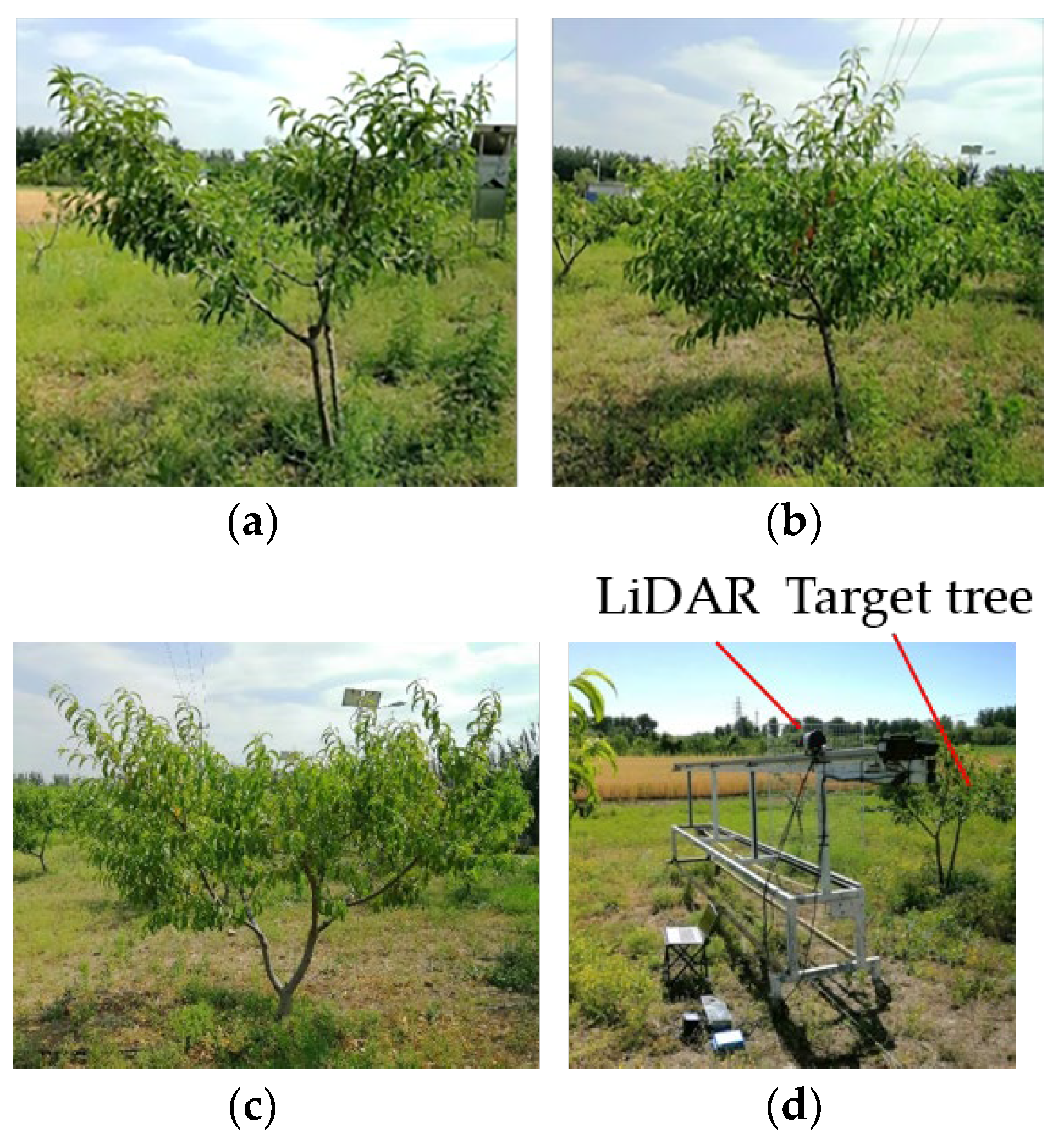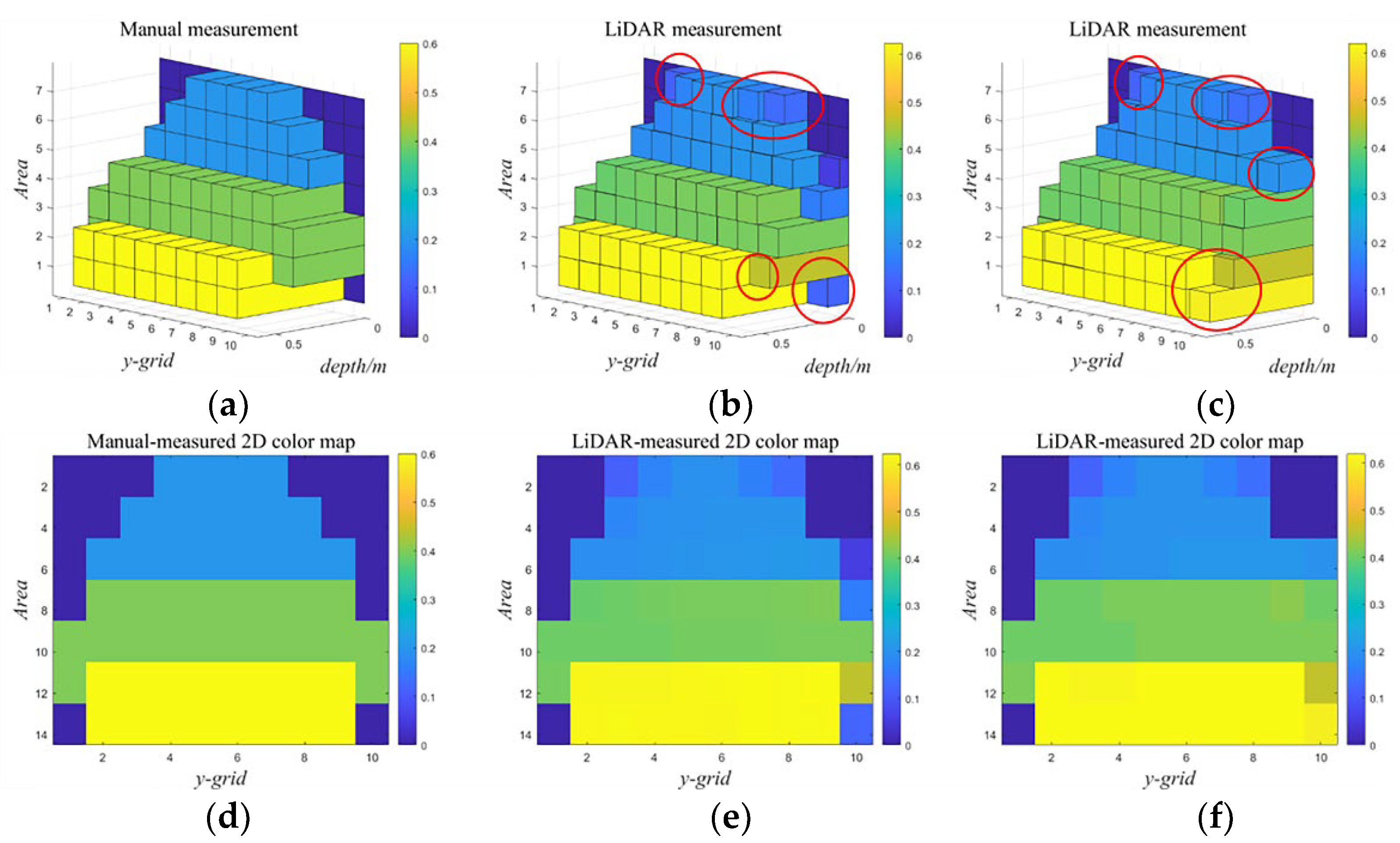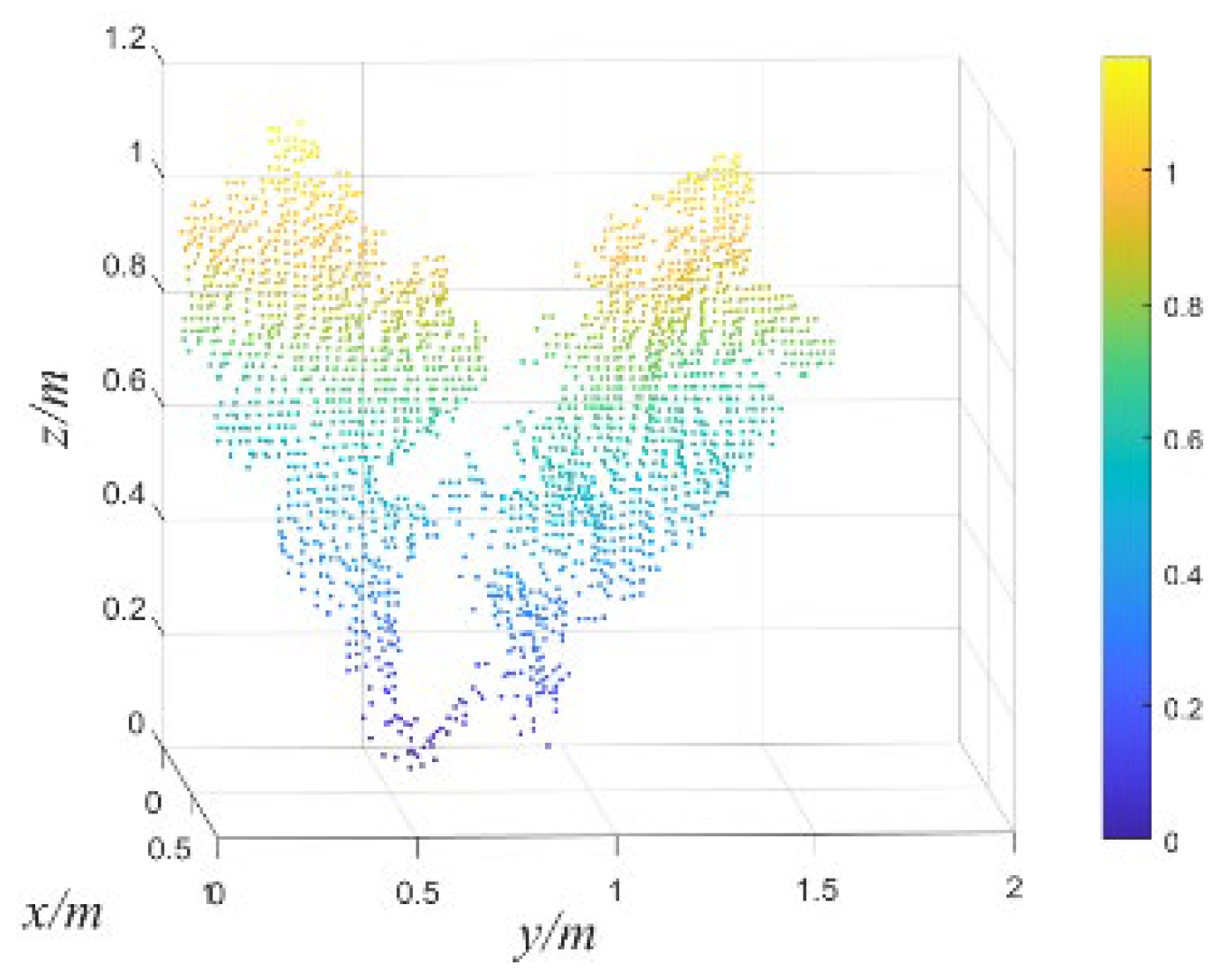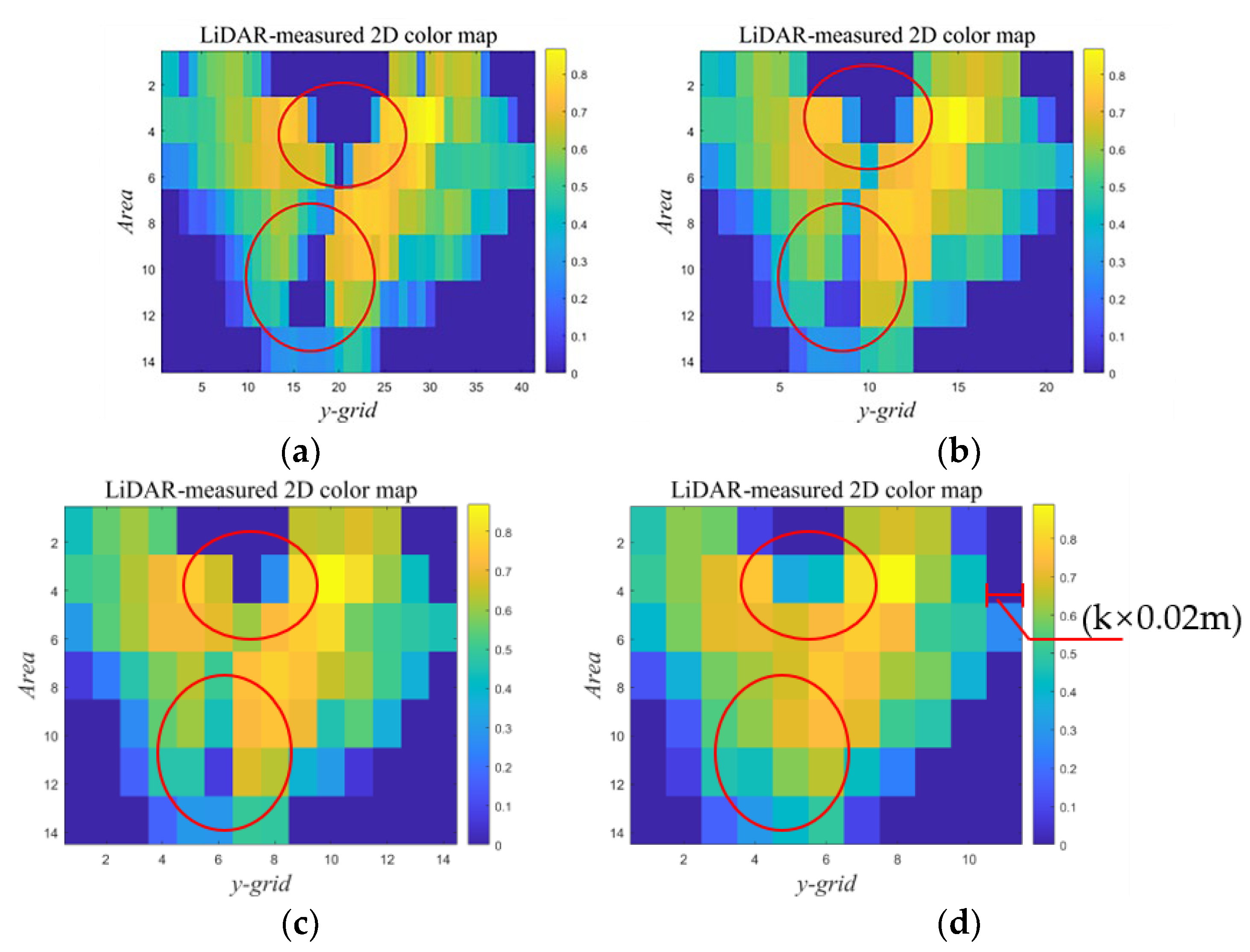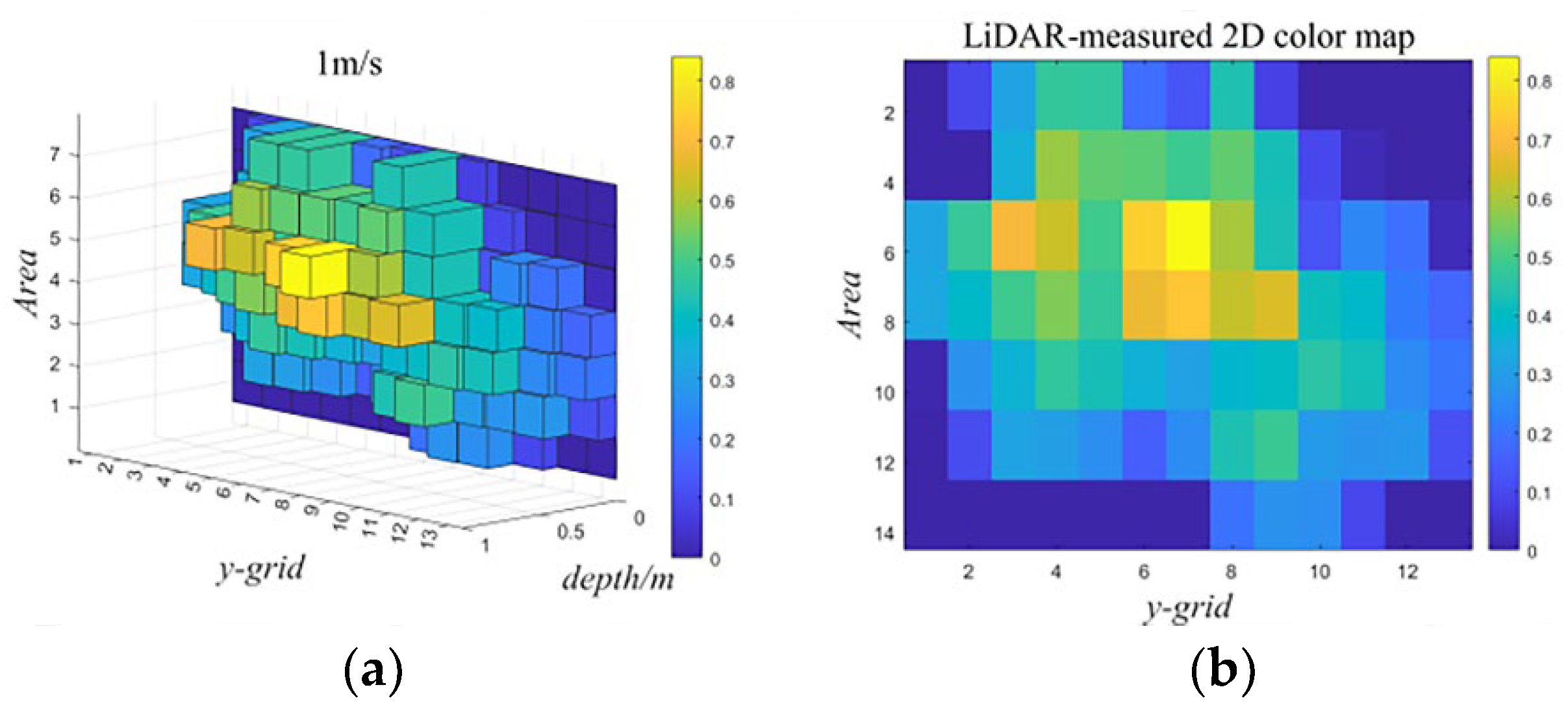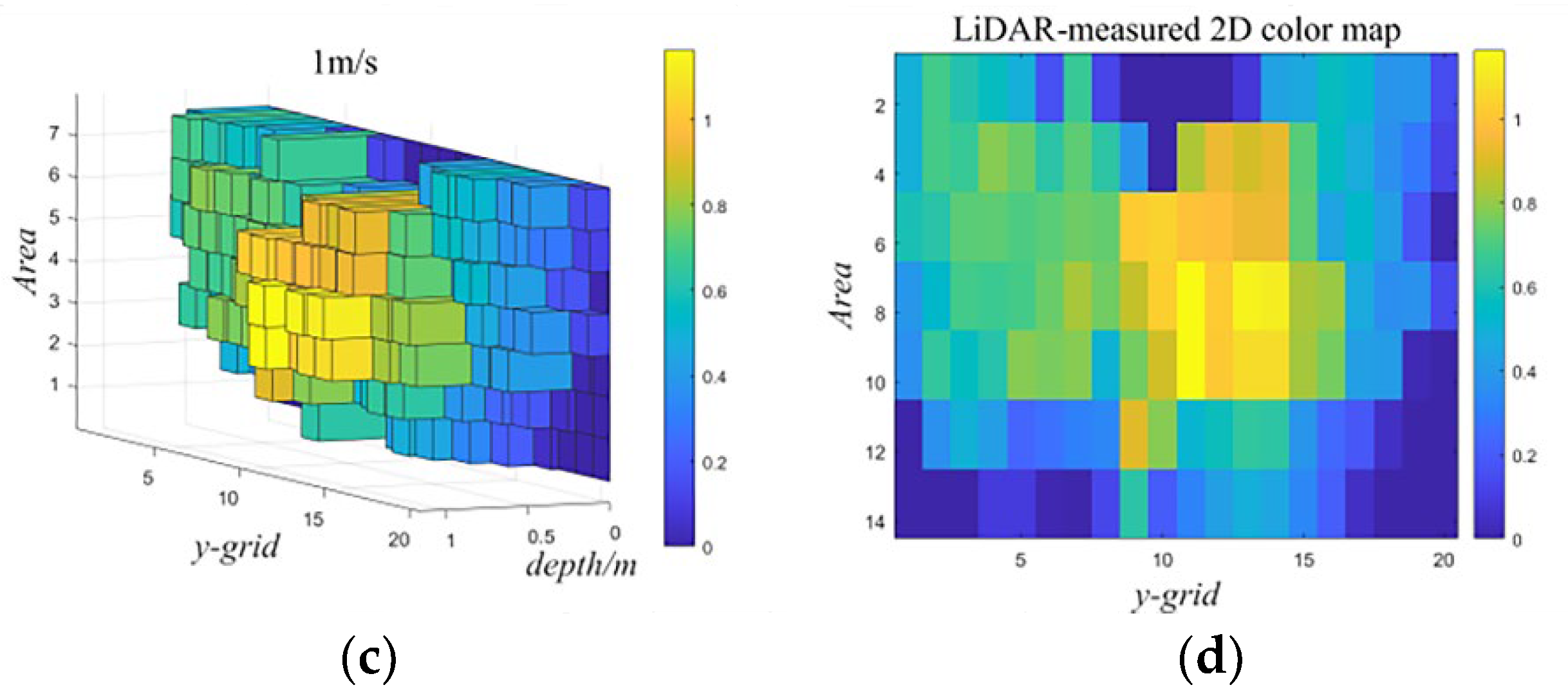1. Introduction
The prevention and control of orchard diseases mainly rely on chemical pesticides. The traditional spraying method is continuous spraying; however, this method creates pesticide waste and environmental pollution caused by excessive spraying [
1]. An accurate target-oriented variable application technology for orchards is an effective way to solve the above problems. It detects the orchard target characteristic information (position, volume, leaf area density, etc.) online through a sensor system, calculates target drug demand, and regulates the variability of drug supply to achieve the on-demand application of pesticides according to target-oriented variables [
2]. The detection of target feature information of fruit trees is a prerequisite for achieving precise and variable spraying. Target feature information has been detected mainly via ultrasonic sensors [
3,
4,
5], light detection and ranging (LiDAR) [
6,
7], and visual sensors [
8,
9,
10]. LiDAR detection can obtain rich target feature information, is not affected by temperature or climate, and has flexible downstream processing methods [
11]. It has become the main method for detecting canopy feature information [
12].
The canopy volume is the basis for the calculation of the precise variable for the spraying amount [
13,
14,
15]. The main canopy volume calculation methods are the regular geometry method [
16,
17], slice method [
18,
19,
20], alpha-shape algorithm [
21], convex hull algorithm [
22], and voxel simulation method [
23,
24,
25]. The regular geometry method describes the canopy as a stack of one or more regular geometries, a method which is more suitable for regularly shaped fruit trees. The slicing method divides the canopy into equal segments horizontally or vertically. The point cloud of each part is projected onto a two-dimensional plane to calculate its contour area, combined with the cumulative calculation of the slice thickness, to obtain a complete canopy volume. This method is suitable for wall-type orchards with small spacing between fruit trees. Both the alpha-shape algorithm and the convex hull algorithm calculate canopy volume by extracting the edge points of the point cloud to form a closed envelope volume. Unlike the convex hull algorithm, the alpha shape-algorithm allows the point cloud contour to have a concave shape, but the convex contour may increase the space and cause erroneous canopy volume calculations. When calculating canopy volumes, the true value of the α parameter for one tree is not necessarily the same for other trees. Thus, the alpha-shape algorithm is more suitable for evaluating the volume of a single fruit tree and is difficult to apply to an entire orchard. The voxel simulation method is a refined regular geometry accumulation method. Its core idea is to use countless small cubes to simulate the canopy to calculate its volume. This method fully considers the internal voids of the canopy, and it performs better than the convex hull algorithm [
26]; however, the accuracy of this method is affected by the size of the voxel, the calculation is complicated, and the calculation burden is large, which is not conducive to the real-time detection of the target volume in orchards.
The above canopy volume detection methods are mainly used to calculate the canopy volume of a single fruit tree. To improve the calculation accuracy of the canopy volume and meet the flow control requirements of a single sprinkler during the spraying of a target-oriented variable, the fruit tree canopy needs to be meshed. Escolà [
27] divided the canopy into multiple horizontal prisms along the tree row and with the height direction as 0.1 m × 0.1 m, and the depth of each horizontal prism was computed as the distance between the two most distant points. The canopy volume was calculated as the total of the horizontal prism volumes. In dense areas, it is difficult for LiDAR to detect deeper canopy layers due to the shielding effect of leaves and the fact that the depth calculation method needs to be optimized. Cai [
28] divided the canopy into a mesh, divided the mesh into sub-meshes, and calculated the mesh volume as the total volume of sub-meshes. This canopy mesh volume detection method can improve the calculation accuracy but requires two sub-mesh divisions, has a high calculation burden, and has limited practical applications. Gu [
29] proposed the canopy meshing-profile characterization (CMPC) method, which divides the canopy into meshes of a fixed size, 0.1 m × 0.1 m, and forms the outer contour of the canopy by finding the thickness of the canopy at the intersection of the meshes to calculate the contour volume. The method can accurately describe the contours of irregular fruit tree canopies, but when calculating the canopy volume, its accuracy is easily affected by the LiDAR moving speed: the larger the speed is, the larger the calculation error.
The purpose of this paper is to propose a LiDAR online detection method for fruit tree canopy volume based on dynamic meshing to reduce the influence of the scanning speed on the detection accuracy of canopy volume and facilitate the establishment of a dosage control relationship between the canopy meshing and the sprayer nozzle. To evaluate the accuracy and applicability of the method, simulation canopy and peach tree canopy detection experiments were carried out, and the detection accuracy errors between the existing canopy volume detection methods and this method were compared. Our results can provide theoretical support for the research and development of a precise, target-oriented, variable spraying control system for orchards.
4. Discussion
Simulated canopy detection tests found that the measured values and the detection values of some grid locations appeared large or small at the locations where there was no carton at the edge of the simulated canopy, and this phenomenon also appeared in Gu’s simulation canopy test [
29]. Through the analysis of the test results, we excluded the influence of the depth values in the CADA method on these edge errors. From the perspective of LiDAR detection principles, the edge errors may be due to the movement-related distortion of the point cloud at the edge of the canopy during the movement of the LiDAR apparatus, resulting in a change in the coordinates of the point cloud and an error in the calculation of the canopy volume. This phenomenon may also exist at the edges of fruit trees. In fact, the LiDAR point cloud will also be affected by terrain and the position and posture of the sprayer to produce point cloud distortion in orchard spraying, which can be reduced by adding point cloud motion distortion compensation during point cloud data processing [
31].
The moving speed affects the detection accuracy of the CADA method. When the LiDAR moving speed is 0.8 m/s, the CADA method has a larger detection error of the canopy of Tree 1, at 17.84%, but the detection accuracies of Tree 2 and Tree 3 are better. Tree 1 has forked canopy branches with large gaps (
Figure 6a), which increases the likelihood of gaps contributing to the mesh volume calculation. Compared with the moving speeds of 0.6 m/s and 1.0 m/s, the mesh width at the moving speed of 0.8 m/s is closer to the width of the canopy gap of Tree 1, and the point cloud at the edge of the gap is prone to motion distortion. This leads to the presence of calculated values in the gaps when the canopy volume is calculated, which increases the detection error. These phenomena verify that the point cloud at the edge of the fruit tree will be distorted, causing detection errors. For the pores behind the outermost leaves in the grid, we included them in the calculating volume. In the future, the team will conduct leaf area detection experiments to evaluate the grid canopy by combining canopy coverage [
26], leaf area, and volume.
The volume value calculated by constructing the canopy contour is larger than the actual value, which is reflected in the verification of the convex hull algorithm and alpha shape algorithm, as well as the methods proposed by Cai and Gu [
21,
22,
27,
28]. Comparative analysis shows that the CADA method reduces the amount counted in the outer margin voids and improves the detection accuracy. However, the calculated value is still larger than the real value, which will cause an increase in the spraying volume. Regarding pest control, this is more beneficial than in the case of a small spraying volume caused by a small detected value of the canopy volume.
The canopy volume calculation method based on mesh division adopts a fixed mesh width for the division [
27], which not only lowers the calculation accuracy of the canopy volume due to the moving speed, but also makes it inconvenient to establish a corresponding relationship with the sprayer nozzle to meet the requirements of target-oriented variable spraying. In this paper, a method for calculating the fruit tree canopy volume based on dynamic mesh division is proposed, and a way of setting the sprayer moving direction and the mesh width in the vertical direction of the canopy is found. It not only reduces the influence of the movement speed on the accuracy of the canopy volume calculation under the fixed mesh width division, but also improves the accuracy over the existing canopy volume detection methods.
5. Conclusions
In this work, a calculation method of canopy dynamic meshing division volumes for precision pesticide application in orchards based on LiDAR was proposed. The feasibility, accuracy, and applicability of the method were verified by simulated canopy and fruit tree experiments with different shapes. The main conclusions were as follows.
(1) The CADA method is suitable for measuring the grid volume of fruit canopies. The accuracy of the CADA method reached 91.67% for the measurement of the simulated canopy and 99.18% for the measurement of the peach canopy at a detection speed of 1 m/s, which is a high accuracy.
(2) With increasing mesh width, the detection accuracy decreased first and then increased. Six LiDAR scanning intervals (0.12 m) were used as the optimal grid width for dynamic partitioning at a moving speed of 1 m/s. The CADA method can be applied to different sizes and shapes of fruit tree canopies, which extends the scope of computer analysis in terms of spraying applications.
(3) The CADA method can reduce the influence of the moving speed on the accuracy of canopy volume detection. Compared with the fixed grid width division method, the measurement accuracy of the CADA method increased by 19.86%, 0.07%, and 6.97%, at the detection speeds of 0.6 m/s, 0.8 m/s, and 1.0 m/s, respectively. Thus, this method can better adapt to the change in orchard operation speed.
(4) Compared with the alpha-shape algorithm and CMPC method, the average errors of the canopy volume detection increased by 2.73% and 7.22%, respectively. The method not only reduces the influence of the LiDAR moving speed on the detection accuracy of the canopy volume, but also improves the detection accuracy over the existing canopy volume detection methods.
The research results provide theoretical support for the research and development of target-oriented variable-rate spraying control systems for orchards. In the future, detection tests of fruit trees for the whole growth period could be conducted to verify the universality of this method. This method could be applied to the target-oriented variable-rate spraying control system to optimize the target-oriented variable spraying of orchards.
